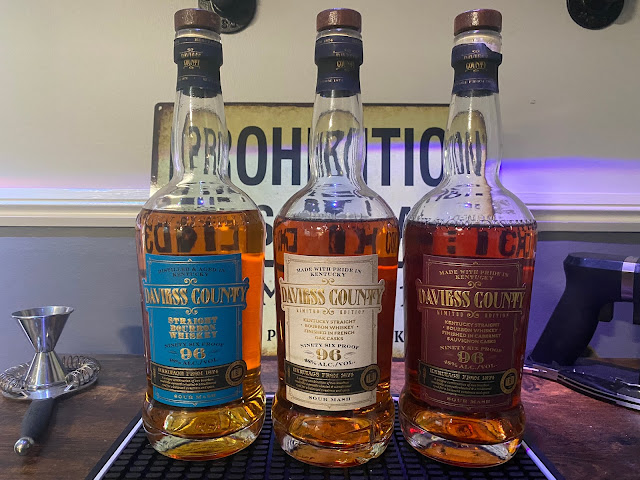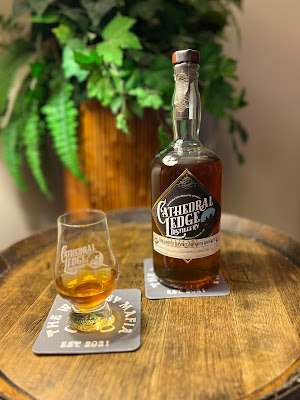Daviess County Flight
A few months ago while finishing my Executive Bourbon Stewards course. I had to put together a tasting flight and describe how I would lead the group through it. Below was my written essay. I am happy to report it was well received.
Good evening ladies and gentlemen and welcome to tonight‘s tasting.
We will be sampling three different whiskeys tonight, all of which are produced by the same distillery, have the same mashbill and are the same proof. However, they taste very different because of the secondary finishes they have undergone. Hopefully by the end of the night you will have a better understanding of how secondary finishes affect the flavor of a bourbon.
Before we start our tasting, let me tell you a brief story of Daviess County Kentucky which these whiskeys pay homage to.
During the pre-prohibition boom of the late 1800s Daviess County KY was a hub of high quality bourbon with over 20 distillers the largest and most well known being Daviess County Distillery which produced some of the best whiskey in the country at the time. When prohibition hit in 1920 Daviess County Distillery was fortunate to survive by producing federally bonded “medical” whiskey. However few if any of the other distilleries in the county were as lucky, thus ending Daviess county’s dominance as a whiskey market, never regained its glory. Even though they survived probation Daviess County distillery fell on hard times and began to change hands finally closing its doors and having its brands discontinued in 1992. Luxco revived the brand in 2020 as a nod to this historic distillery and the county it was named after.
I know, I know quit talking and let us drink! In front of you you have (3) 1 ounce pours.
- Daviess Straight Bourbon
- Daviess French Oak Cask Finish
- Daviess Cabernet Cask Finished
All these whiskeys, (notice I didn’t say bourbon, because only one of the three is actually bourbon) started out the same way as straight bourbon. Luxco distillery starts out by blending A two year old wheated bourbon, and a two year old rye bourbon, they are then proofed down to 96% creating their base four grain Bourbon. Corn, Wheat, Rye, Barley.
Then the French Oak and Cabernet are finished in used casks and are no long legally allowed to be called bourbon.
Let’s get started by picking up each glass looking at the color, notice when comparing the first pour to the other two glasses it’s a lighter amber in appearance. Since this is the straight bourbon aged for 2 years it has less time in the barrel partially accounting for the light color. The remaining color change is due to the finishing process and what the barrels contained before the bourbon was introduced.
Now bring each glass slowly up to your nose one at a time. Don’t go in too fast or you may overwhelm and anesthetize your sense of smell, making nosing impossible. This can last for hours. Try to start a few inches away moving it slowly in and side to side until you just start to pick up the aroma. You will likely discover subtle differences. If you can’t name the differences that’s ok, that will improve with time and practice. Your sense of smell is strongly tied to memory, if you have never smelled cinnamon you can’t identify it in your whiskey. But if you grew up baking you’ll likely pick it up very strongly, it may even trigger specific memories from that time in your life. The great thing is that no matter what you smell you’re right, and the person sitting next to you may smell something totally different and they are right too. It’s all subject to your memories.
Nosing suggestion, try leaving your mouth slightly open and gently inhale through both your mouth and your nose. This should help better identify some of those faint notes.
So Finally let’s taste!
Sip, don’t shoot your whiskey, at least if you’re drinking for taste.
Your first sip will likely be hot, strong, and overwhelming, this is totally normal. Your brain’s interpretation of alcohol is that of poison, which if you drink too much of course can be. But after that first sip your brain & taste buds relax, the heat starts to settle down and you should be able to start picking up flavors.
On your second small sip, let it coat your mouth. Does it coat your mouth with an oily feeling, or is it thinner and more watery? Is the burn on the tip of your tongue, sides or back? What is the very first flavor you think of? Is it pepper, caramel, mint, sweet, fruity, or fresh baked bread? Again there is no wrong answer it’s subject to your pallet. So is there only a single note, or multiple flavors? That shows complexity. Now swallow, do you get different flavors that come through? Dry, tannic, leather, coffee, dark chocolate, these are often flavor descriptions of bourbon. Does the flavor leave immediately or does it linger, that can be described as a short or long finish. Do you feel the warmth in your throat, chest and finally belly, well that’s what we call a KY hug.
So now do this with each of our three whiskeys, saving just a little of each. Make some notes as you go.
Now go back to the first one and start again, do you find the same flavors as before or has the whiskey “opened up” or changed?
Tasting suggestion, it’s perfectly acceptable and even recommended to add just a drop or two of water on the second pass. This helps fracture the molecules and releases more flavor into the vapor in the glass.
So which was your favorite? Could you tell them apart? If not don’t worry it can take years of practice to get good at nosing and tasting. But the good thing is now if your partner complains about your drinking you can just tell them you’re practicing your nosing and tasting skills.
Thank you, and I hope you have enjoyed tonight’s tasting.



Comments
Post a Comment